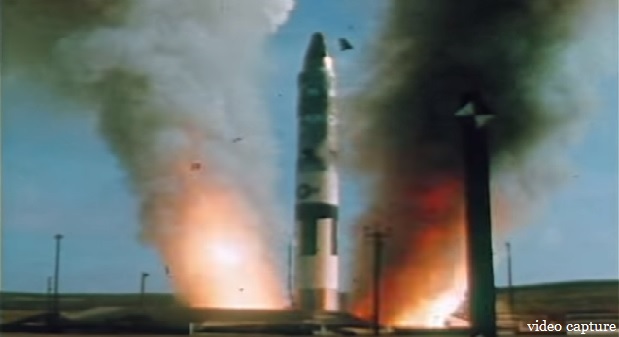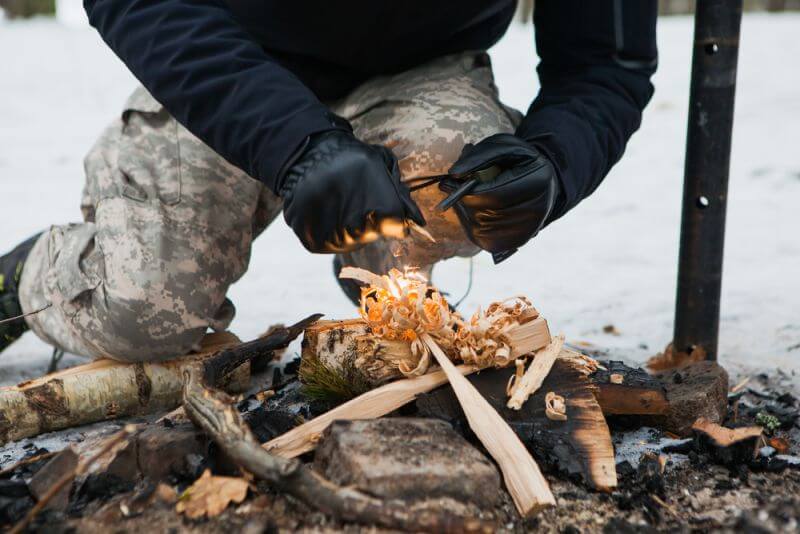For the last year, tensions have been running high between the United States and North Korea. Increased missile testing by North Korea, with each generation of missiles being more capable than the last, has turned the age-old North Korean threats of nuclear war into a reality that can’t be ignored. Government officials at all levels are renewing emergency plans for nuclear war.
In this, we have returned to the Cold War with the now-defunct Soviet Union. The threat of thermonuclear war, between what were then the world’s two superpowers, caused emergency agencies to stay on their toes, ever watchful for a missile launch that could indicate the end of the world. That sort of watchfulness has once again become real in organizations like NORAD and the Hawaii Emergency Management Agency.
Reinstating Cold War policies means reinstating the necessary systems, as well as testing those systems. It was a simple error in such a test which triggered panic in the Hawaiian Islands on Saturday the 13th. An employee coming on shift ran a test drill of the Emergency Missile Warning System, a normal part of his duties since last November.
But this time, the test went awry. A simple operator error, making the wrong selection off of a drop-down menu on a computer screen, sent the citizens of that state into panic. Rather than selecting “Test missile alert” the operator selected “Missile alert” the type of mistake we all make on our computers on a nearly daily basis.
Of course, when you and I make that sort of mistake, all we usually need to do is click on undo on whatever computer program we are using, in order to rectify the problem. But in this case, there was no undo. The warning went out across the state, informing everyone of a non-existent inbound missile.
One would think that it would be hard to make such a mistake, but in today’s computerized world, it is actually much easier than ever before. While the computer program had one of those infamous “Are you sure” dialog boxes for the operator checked that as well, quite possibly without even reading it.
Since there was no second person in the loop as a fail-safe, the alert went out, creating panic.
Sadly, but predictably, those on the political left are following their mantra of “never let a good crisis go to waste” and blaming President Trump. But Trump had nothing to do with this; nor did the federal government.
The only way the federal government was involved, was that FEMA had authorized use of their emergency notification system. But even that had nothing to do with the present administration, but rather, the past one.
That’s not to say that FEMA didn’t get involved. One of the problems that this false alarm brought to light was that there was no easy means in place to post a retraction. State officials, working with representatives of FEMA had to come up with a quick fix system to post that retraction, which delayed notifying the population of the error by 38 minutes (actually, very fast by government standards).
So there was no real emergency and no real danger at any point in the process, other than that caused by panicking people. Nevertheless, it was a unique situation and one that we can learn from. So, what sorts of lessons can we find in this blunder?
First of All, Missile Threat Warnings
The task of notifying the population of an inbound nuclear missile is a huge one. There are over 320 million people in our country that would need to be notified. About the only good thing that can be said is that the federal government has had decades to develop, implement and test the necessary systems.
Even so, I’m sure that there are parts of the country, where people would not be informed.
The entire process starts with a worldwide network of sensors, including satellites. These monitor the surface of the earth, looking for missile launches, nuclear explosions and other events that could pose a threat to the United States.
All this information goes to NORAD, which is once-again housed in their bunker under Cheyenne Mountain.
NORAD’s job is to inform the military and the executive branch of the government, specifically the president, of any launches. They then monitor the launch, projecting the course of the missile and determining where it will land.
But this takes time. The mathematics of ballistic flight are well known, but they have to have enough of a course track to make that determination. So, the first notice that goes out is just a preliminary warning. At that point, they usually don’t even know if it is aimed at the United States.
As the minutes pass, NORAD is able to refine their information and projections. But it can be 10 to 15 minutes before they can identify the exact city that a missile will hit, assuming that it is fused for an airburst in the lower atmosphere. If it is fused for the necessary high-altitude burst to cause an EMP that would blanket the country, they might not know until the bomb goes off.
Missile flight time from North Korea to the central United States is roughly 38 minutes. If you shave 10 to 15 minutes off of that, by the time that the exact point of impact is known, and another few minutes to make the decision to inform the public and get the orders out, by the time the FCC’s Emergency Alert System is put into action, you and I will receive only 15 to 20 minutes of notice, before the nuclear bombs on those missiles go off. That’s it.
The Emergency Alert System uses radio and television to get the word out about pending nuclear strikes and other emergencies. In addition, FEMA’s Integrated Public Alert & Warning system (IPAWS) sends out alerts via text message, the internet, through landline phones and digital highway signs. This ensures the maximum number of people are informed as quickly as possible.
This same system allows emergency information to be sent out for other types of emergencies as well, but those are not our concern at this time.
How to React to a Missile Warning
Missile alerts are general. In other words, we will have no way of knowing how large the warhead is or how it is fused for detonation. So we have to assume the worst and take action based upon that. As the government’s emergency notification systems are geographically specific, receiving a notification means that it is coming towards you, not heading somewhere halfway across the country.
There are two parts to surviving conventional nuclear war: surviving the blast and surviving the fallout. Either one can kill you, even though one will kill you much quicker than the other.
A nuclear blast emits several different types of energy, but for our purposes the important ones are heat, radiation and blast (wind). The farther you are from the point of impact, the lesser any of these will be, but severe damage and injury can still happen as much as 20 miles from the point of impact, depending on the size of the nuclear device and the altitude that it is detonated at.
You should be able to make a guess on how close you are going to be to the blast, based upon the potential targets in your area and where you live. If there are military targets in your city, then you would measure your distance from those targets.
If your city is being attacked as an attack against the civilian population, then the explosion would probably take place downtown, so the farther you are from downtown, the better.
In any case, your best protection is to be underground, in a prepared shelter or bunker. If you don’t have a bunker available, the basement of your home is a good second choice. Likewise, the basement of an apartment or office building will offer more protection than being above-ground. Even an underpass or tunnel offers some protection from a nuclear explosion.
How To Build a Small Bunker in Your Backyard with $400
So the key thing to do, when you receive notification of a ballistic inbound, is to get underground. If you can’t, then seek shelter behind a stout barrier (like a concrete retaining wall), putting the barrier between you and the likely point of impact.
You’ll want to stay in your shelter until after the blast, the wind following the blast and the return wind, as air collapses back to the point of impact. Like a wave approaching and receding from the shore, the windstorm that the detonation causes, radiating outwards from the blast, will return back to the original point of impact.
This is what causes the characteristic mushroom cloud of a nuclear blast.
That same shelter might serve well as a fallout shelter over the next days or even weeks. If you ended up sheltering outdoors, because there was no building nearby, you’ll want to find your way to indoor shelter as quickly as possible, so that you can wait out the fallout. Stay in that shelter until you receive the “all clear” order from the military or government officials.
The only exception would be if you come down with radiation sickness, in which case you should seek medical attention as quickly as possible.
Preparing for Conventional Nuclear War
With the short amount of notice that any of us would receive to an inbound nuclear attack, there really won’t be time to prepare. You’ve got to prepare a safe place to retreat to before such a warning were issued, or it will be too late.
As I already mentioned, the safest place you can be is underground, if at all possible. If you live in a part of the country where the homes don’t have basements, you’ll need to shelter in your home. That’s not ideal, but it’s still better than being out in the open.
You may end up staying inside that shelter for as much as 21 days, without coming out. So you will have to prepare everything you’ll need for surviving that 21 days and have it stored in the shelter. This includes, food, water, sanitary products, some means of disposing of human waste and whatever you will need to meet your family’s medical needs.
It would be a good idea to have a supply of potassium iodine in your shelter as well, along with dosage information for every member of your family. As with many medications, this varies by the individual’s weight. A good hand-crank radio to receive news and notifications over would also be useful.
Train your family of what to do, as well, especially your children. You won’t have time to go to their school and bring them home, unless you happen to live across the street from the school. Rather, you’re going to have to take care of yourself and expect them to take care of themselves.
Otherwise, if you try and rescue them, you might not survive to take care of them.
But if it’s an EMP Attack
While a conventional nuclear strike would be devastating, killing millions of people, that’s nothing compared to the devastation that a high-altitude EMP could cause. In such a case, there won’t be any huge boom, no flashing light in the sky, and no wind or heat to deal with.
All that will appear to happen is that the power will go out and every electronic device will stop working suddenly, even many that are battery powered.
The problem with an EMP isn’t surviving the attack, but surviving the aftermath. Without electricity, most of what we depend on to survive will no longer function. We won’t have heat and cooling in our homes, our refrigerators won’t work, city water service will come to a standstill, sewage lines will stop up and the stores will be empty.
This is probably one of the worst survival situations we can face. It would require becoming totally self-sufficient, harvesting and purifying our own water, growing our own food and heating our homes with wood fires. Preparing for such a scenario is a massive undertaking, one which several entire books have been written about.
One Final Word
As we can see from the false alarm that happened in Hawaii, our government officials aren’t perfect. They can and do make mistakes, just like the rest of us. The difference is, when they make those mistakes, it affects the lives of many more people.
The opposite can happen too. Before Hurricane Harvey reached Houston, city officials contemplated evacuating the city. They ultimately decided not to, because of the problems associated with the evacuation for Hurricane Rita, 12 years earlier.
That threat never manifested, which made the evacuation a greater danger to those who followed the evacuation order, than staying at home would have been.
So don’t just depend on the government to tell you what to do. Develop your own sources of information and make your own decisions. Yes, you will make errors too, but you might not make the same errors that the government is making.
This article has been written by Bill White for Survivopedia.









pelagiaeast | January 16, 2018
|
And the shelters were locked?????? Seems to me this is a Very big disclosure from this ‘mistake.!
RLABruce | January 16, 2018
|
Even if “operator error” is the real reason for this mistake, the computer software as it is described needs some work as well. The REAL Missile Alert should be launched from a separate menu from all Test Drills and other functions, and the text should be all in RED, all caps, and larger text than normal. In addition, there should be two or three messages that warn the operator, “This is NOT a drill! Are you SURE you want to broadcast a genuine warning?” Given the circumstances in which a real warning is issued, an audible warning siren wouldn’t be too excessive, sounding as soon as the menu is opened.
Either they had a real incoming missile that was quietly handled, or the warning software is so poorly designed the designers should be sued for their negligence. I used to do minor software design, and I created better warnings to operators that mere data will be deleted! I certainly expect better performance from such a critical mission function.
Ron Rietz | January 16, 2018
|
Agree, in addition, there should be two (or more people required to send such a message. It should not have ‘this is not a drill’, just leave out ‘this is an exercise. Unless you were one of the individuals who went to the sewer system – no harm was done – there must be a review of PROCEDURES both for the senders and the recipients.
Henry Roop | January 16, 2018
|
A geiger counter is also a must, so you will know the amount of radiation in case of multiple warheads.
Ted | January 16, 2018
|
Number one, why didn’t ANY government workers go into emergency mode? They just watched all of these idiots running around like chickens with their heads cut off, because there was, intentionally, NO ONE there to tell them what to do!
Number two, Why should anyone have faith in a system that is being manned by someone that only gets minimum wage, and probably never graduated from junior high school?
Number three, If you’re on a little bitty island there will be nowhere to run to and nowhere to hide from a nuke! You might as well grab some lawn chairs, a few cold ones, and enjoy the fireworks!
We’re all on our own Folks, the traitors infesting our government & courts would rather see us all dead anyway!
Myself, I wish they would just push the button and be done with it already! I grow tired of their foolish behavior!
stormy | January 16, 2018
|
We are definitely on the same page, ted. this highlighted some major discrepancies that, sorry, we mainlanders need to be hearing as well.
aren’t there lots of lava tubes in hawaii? i know on the big island but all the islands were created by the same volcanic processes..
Farmer Phyl | January 16, 2018
|
When someone knocks on your door and says “I’m from the government, I’m here to help” that’s the time to get scared. So Why do so many people actually think the government will rescue them? If you leave it to the government or groups like the Red Cross, you may survive but you’ll suffer much more than if you are prepared to take care of yourself. Remember, it took 5 days just to get water to the Superdome. People can only live 3 days without water!
stormy | January 16, 2018
|
Big thumbs up farmer phyl. People with their oh so big brains and education and good food should be able to think this through. why the heck weren’t the Hawaiians thinking for themselves? Kind of a super vulnerable spot out there in paradise! I tried living half a day without water and i became an animal, looking for muddy puddles! I kid you not. people are just going to turn zombiefied or go ballistic or check out altogether.. Have you been paying attention to this new gsm? the eddy minimum? this is a must to prepare for. i know, all this little boy crying wolf…and now we have a real catastrophe…80 to 100 percent assured. Every 206 years. clockwork. 206 years ago people were a bit more self sufficient. new madrid fault…is the biggest worry. John. l casey, upheaval…
Jerry D Young | January 16, 2018
|
Excellent article. Good insights.
Just my opinion.
stormy | January 16, 2018
|
I LIVED IN HAWAII AS A KID AND SO BECAME ocd when this happened. there was no mistake. if anyone believes that too simplistic lie…guess what the newest ‘rumor’ is? A rogue american submarine captain, they hawaii? had been trying to follow out there in the pacific for months (this fits with the information from governor and vern) guess this sub raised up and shot an icbm that we were able to blow up and we blew up the submarine with rogue captain and all of the crew.
hawaii got something good out of this test? a wake up call that no one to include tourists are in the least prepared for anything…
sheepfangs | January 17, 2018
|
“I’m from the government – I’m here to help!” I hope I never hear those words,. my mindset is that if they tell me to go – i’ll probably bug in, but if they say to stay put i will damn skippy haul ass!!!